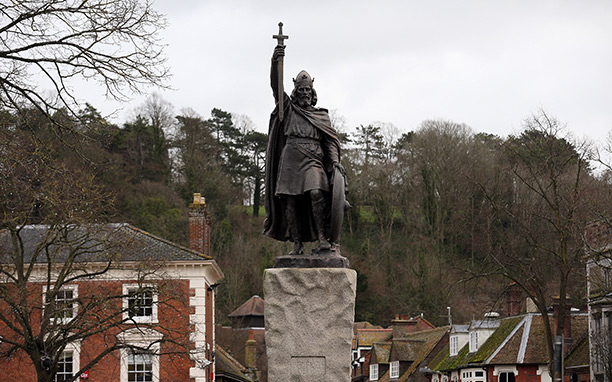 Exhuming historical characters makes for dramatic headlines and can seem a great way to get easy answers, but we should think twice before disturbing the remains of dead monarchs, says Justin Pollard.
Exhuming historical characters makes for dramatic headlines and can seem a great way to get easy answers, but we should think twice before disturbing the remains of dead monarchs, says Justin Pollard.
di Justin Pollard in History Today Volume: 63 Issue: 4 2013 ![]()
The discovery of the mortal remains of Richard III under a car park in Leicester is being hailed as one of the archaeological discoveries of the decade. A car park is an undignified place for a king to spend eternity and the unmarked nature of the grave could have led to the grave being disturbed in future by building work. Few would argue, then, against the recovery and reburial of such a body. But the discovery has stirred up a rather gothic desire, at least among newspaper editors, to go in search of other ‘missing’ historical figures or even simply to take a second look at those whose resting places we know.
It is not the first time there has been a craze for tomb opening. In 1774 the lid was lifted on the austere tomb of Edward I in Westminster Abbey, revealing the king ‘richly habited, adorned with ensigns of royalty, and almost entire’.
This discovery itself started a tradition for more local tomb-openings, with groups of dignitaries petitioning their vicars for the right to open up the grander medieval monuments in their parishes. At Danbury in Essex in 1779 just such a group not only opened the sealed lead coffin of a medieval knight to discover his flesh was still ‘exceedingly white and firm’, but the strange preserving liquor it was lying in provoked such historical curiosity that one of the party later noted:
We were presented with a view of the body, laying in a liquor or pickle, somewhat resembling mushroom catchup, but of a paler complexion, and somewhat thicker consistency. As I never possessed the sense of smelling, and was willing to ascertain the flavour of the liquor, I tasted and found it to be aromatic, tho’ not very pungent, partaking of the taste of catchup and of the pickle of Spanish olives.
The days of tasting the occupants of tombs are thankfully long gone but, since the discovery of Richard III, a surprising number of people have been clamouring for more exhumations. A local councillor on Ashford borough council has already been in touch with the Leicester team who analysed Richard III, inviting them to excavate a grave in St Mary’s Church in Eastwell which, legend has it, is the final resting place of one of Richard III’s illegitimate sons.
The craze for Plantagenet DNA sequencing has also brought the thorny issue of the Princes in the Tower back into the limelight. The two children’s skeletons, discovered at the Tower of London in 1674 and believed by some to be the remains of the princes, were moved to an urn in Westminster Abbey by Charles II and were last examined in 1933. At that time the eminent anatomist Professor William Wright and the president of the Dental Association, Dr George Northcroft, made an exhaustive study but did not have the techniques of accelerator dating or DNA sequencing available to help determine beyond reasonable doubt the age and paternity of the remains. That could, of course, now be resolved.
But the greatest clamour is for finding Alfred the Great. As soon as Richard III was located there were calls to exhume Alfred. The parallels were obvious – a famous king lying in an unmarked grave under a car park – this time in Winchester. Surely Alfred deserved the same respect as Richard and a handsome new tomb, fit for a king, in a cathedral setting.
But the story isn’t quite that simple. Alfred has not rested easy in his tomb. Originally buried in the Old Minster at Winchester in 899, his body was transferred to the New Minster shortly after. However in 1109 Henry I ordered the monks of the New Minster move to Hyde Abbey just outside the city walls, making way for the construction of a Norman Cathedral. The bones of Alfred, his wife Ealhswith and his son Edward the Elder travelled with them to their new home, where they were reburied in front of the altar.
After the Dissolution Hyde Abbey was turned into a private house and much of the stone work was ‘robbed out’ for use elsewhere. In 1788 the property became a Bridewell – a ‘house of correction’ – and one of the first jobs given to the prisoners was to clear the site of rubble in the grounds. During the work to clear the governor’s garden a warden reported to Captain Howard, an antiquarian, that the high altar had been located and three graves unearthed in front of it. This was not an age of sentiment and the prisoners were apparently unmoved by the discovery of the tombs. They were almost certainly unaware of their occupants. As Howard records, they discovered that Alfred’s tomb was made from a single block of stone encased with lead. The prisoners stripped off the lead and sold it, emptied out the bones and fragments of clothing, then broke up the coffin and reburied it empty. So Alfred’s now unidentifiable remains are probably lying scattered in the topsoil somewhere between what is now a row of Victorian houses and a car park.
So finding Alfred will be considerably harder than finding Richard. Which begs the question should we even look? Of course historians want to ‘know’ and new scientific tests tempt us with the sort of definitive results that are so rare in historical study. But these are graves and there is an ethical argument to consider before the excavators move in. We should also never forget that archaeology is a destructive one-time experiment. Where a site is not threatened should we not leave it for future generations, who will have better tools and greater skills? Alfred may be scattered widely, but he’s resting safely. There is still plenty to discover about Alfred without having his bones, however strangely fascinating the prospect of looking at his mortal remains might be.
Justin Pollard is the author of Alfred the Great: the Man who Made England (John Murray, 2005).
__________________
Inserito il 5 aprile 2013


